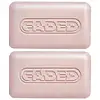What's inside
What's inside
 Key Ingredients
Key Ingredients

 Benefits
Benefits

 Concerns
Concerns

 Ingredients Side-by-side
Ingredients Side-by-side

Water
Skin ConditioningAmmonium Lauryl Sulfate
CleansingCocamidopropyl Betaine
CleansingSodium Chloride
MaskingSodium Methyl Cocoyl Taurate
CleansingNiacinamide
SmoothingHelianthus Annuus Seed Oil
EmollientBetaine
HumectantAzelaic Acid
BufferingSodium Benzoate
MaskingGlycerin
HumectantRhamnose
HumectantGlucomannan
Skin ConditioningDaucus Carota Sativa Seed Oil
EmollientDaucus Carota Sativa Root Extract
Skin ConditioningBeta-Carotene
Skin ConditioningPolyglycerin-6
HumectantPropanediol
SolventXylitylglucoside
HumectantAnhydroxylitol
HumectantTocopherol
AntioxidantXylitol
HumectantTerminalia Ferdinandiana Fruit Extract
AntioxidantGlucuronic Acid
BufferingGlucose
HumectantXanthan Gum
EmulsifyingPhenoxyethanol
PreservativeParfum
MaskingPotassium Sorbate
PreservativeCitric Acid
BufferingHydroxypropyl Guar
Emulsion StabilisingHydroxypropyl Guar Hydroxypropyltrimonium Chloride
Styrene/Acrylates Copolymer
Coco-Glucoside
CleansingGeraniol
PerfumingLimonene
PerfumingCoconut Acid
CleansingWater, Ammonium Lauryl Sulfate, Cocamidopropyl Betaine, Sodium Chloride, Sodium Methyl Cocoyl Taurate, Niacinamide, Helianthus Annuus Seed Oil, Betaine, Azelaic Acid, Sodium Benzoate, Glycerin, Rhamnose, Glucomannan, Daucus Carota Sativa Seed Oil, Daucus Carota Sativa Root Extract, Beta-Carotene, Polyglycerin-6, Propanediol, Xylitylglucoside, Anhydroxylitol, Tocopherol, Xylitol, Terminalia Ferdinandiana Fruit Extract, Glucuronic Acid, Glucose, Xanthan Gum, Phenoxyethanol, Parfum, Potassium Sorbate, Citric Acid, Hydroxypropyl Guar, Hydroxypropyl Guar Hydroxypropyltrimonium Chloride, Styrene/Acrylates Copolymer, Coco-Glucoside, Geraniol, Limonene, Coconut Acid
Hydrogenated Vegetable Oil
EmollientSodium Cocoyl Isethionate
CleansingWater
Skin ConditioningPolyglyceryl-4 Laurate
EmulsifyingGlycerin
HumectantButyrospermum Parkii Butter
Skin ConditioningCI 77891
Cosmetic ColorantSodium Chloride
MaskingAscorbic Acid
AntioxidantAzelaic Acid
BufferingKojic Acid
AntioxidantMelatonin
AntioxidantNiacinamide
SmoothingUrea
BufferingLactic Acid
BufferingCI 77491
Cosmetic ColorantCarica Papaya Fruit Extract
Skin ConditioningCI 77499
Cosmetic Colorant
 Reviews
Reviews

Ingredients Explained
These ingredients are found in both products.
Ingredients higher up in an ingredient list are typically present in a larger amount.
Azelaic acid is a multitasker ingredient that helps treat acne, pigmentation, and irritation. It is a great option for sensitive skin.
What makes azelaic special?
The best thing about azelaic acid is it's gentleness. It's generally well-tolerated and safe to use alongside other actives like niacinamide or salicylic acid.
Unlike AHAs, azelaic acid will not make you photosensitive/sun sensitive.
You can find this ingredient naturally occurring in grains like wheat, rye, and barley. In cosmetics, azelaic acid is typically lab-made, which is more stable and effective.
Learn more about Azelaic AcidGlycerin is already naturally found in your skin. It helps moisturize and protect your skin.
A study from 2016 found glycerin to be more effective as a humectant than AHAs and hyaluronic acid.
As a humectant, it helps the skin stay hydrated by pulling moisture to your skin. The low molecular weight of glycerin allows it to pull moisture into the deeper layers of your skin.
Hydrated skin improves your skin barrier; Your skin barrier helps protect against irritants and bacteria.
Glycerin has also been found to have antimicrobial and antiviral properties. Due to these properties, glycerin is often used in wound and burn treatments.
In cosmetics, glycerin is usually derived from plants such as soybean or palm. However, it can also be sourced from animals, such as tallow or animal fat.
This ingredient is organic, colorless, odorless, and non-toxic.
Glycerin is the name for this ingredient in American English. British English uses Glycerol/Glycerine.
Learn more about GlycerinNiacinamide is a multitasking form of vitamin B3 that strengthens the skin barrier, reduces pores and dark spots, regulates oil, and improves signs of aging.
And the best part? It's gentle and well-tolerated by most skin types, including sensitive and reactive skin.
You might have heard of "niacin flush", or the reddening of skin that causes itchiness. Niacinamide has not been found to cause this.
In very rare cases, some individuals may not be able to tolerate niacinamide at all or experience an allergic reaction to it.
If you are experiencing flaking, irritation, and dryness with this ingredient, be sure to double check all your products as this ingredient can be found in all categories of skincare.
When incorporating niacinamide into your routine, look out for concentration amounts. Typically, 5% niacinamide provides benefits such as fading dark spots. However, if you have sensitive skin, it is better to begin with a smaller concentration.
When you apply niacinamide to your skin, your body converts it into nicotinamide adenine dinucleotide (NAD). NAD is an essential coenzyme that is already found in your cells as "fuel" and powers countless biological processes.
In your skin, NAD helps repair cell damage, produce new healthy cells, support collagen production, strengthen the skin barrier, and fight environmental stressors (like UV and pollution).
Our natural NAD levels start to decline with age, leading to slower skin repair, visible aging, and a weaker skin barrier. By providing your skin niacinamide, you're recharging your skin's NAD levels. This leads to stronger, healthier, and younger looking skin.
Another name for vitamin B3 is nicotinamide. This vitamin is water-soluble and our bodies don't store it. We obtain Vitamin B3 from either food or skincare. Meat, fish, wheat, yeast, and leafy greens contain vitamin B3.
The type of niacinamide used in skincare is synthetically created.
Learn more about NiacinamideChances are, you eat sodium chloride every day. Sodium Chloride is also known as table salt.
This ingredient has many purposes in skincare: thickener, emulsifier, and exfoliator.
You'll most likely find this ingredient in cleansers where it is used to create a gel-like texture. As an emulsifier, it also prevents ingredients from separating.
There is much debate on whether this ingredient is comedogenic. The short answer - comedogenic ratings don't tell the whole story. Learn more about comegodenic ratings here.
The concensus about this ingredient causing acne seems to be divided. Research is needed to understand if this ingredient does cause acne.
Scrubs may use salt as the primary exfoliating ingredient.
Learn more about Sodium ChlorideWater. It's the most common cosmetic ingredient of all. You'll usually see it at the top of ingredient lists, meaning that it makes up the largest part of the product.
So why is it so popular? Water most often acts as a solvent - this means that it helps dissolve other ingredients into the formulation.
You'll also recognize water as that liquid we all need to stay alive. If you see this, drink a glass of water. Stay hydrated!
Learn more about Water